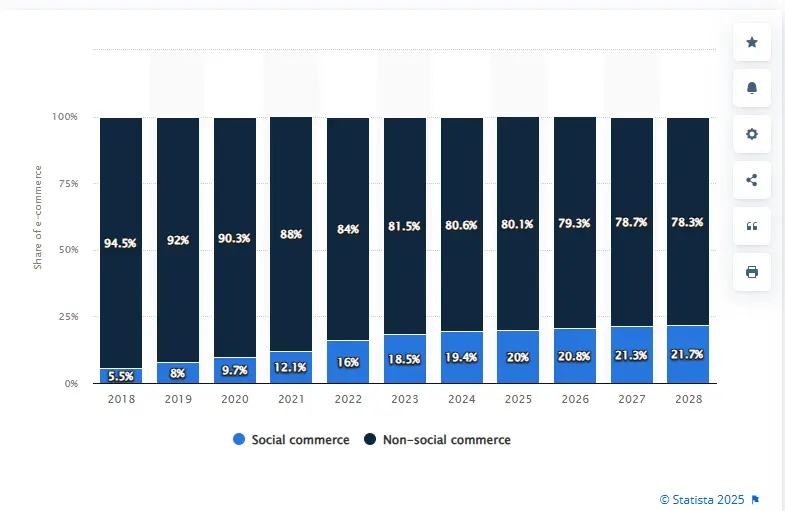Gone are the days when ecommerce was the new thing. Since the internet has been with us for so long, we even have new terms, such as “digital commerce,” that underscore how this is a new era of online commerce.
We can translate digital commerce as the digital transformation of ecommerce. That is to say: heavy use of advanced technologies—like Machine Learning, AI, chatbots, Natural Language Processing and more—channel integration, customer-centricity, social commerce, Composable Commerce, etc.
This evolution means that every interaction, from the first click to the final purchase, is thoughtfully designed to be smarter, faster, more engaging, and more tailored.
What is digital commerce?
Digital commerce goes beyond simple online transactions. It encompasses the entire process of buying and selling products and services through digital channels.
Think of it as the backbone of modern retail—a system that unifies online stores, mobile apps, social media, and even physical outlets into a cohesive whole. At its core, digital commerce leverages cutting-edge technologies to deliver unique, personalized experiences.
This approach includes everything from search functionality to customer data analytics. Retailers use these tools to understand shopper behavior and deliver recommendations that feel tailor-made for each consumer.
Also, digital commerce platforms are built to be agile. They must quickly adapt to shifting consumer demands and integrate powerful strategies, like Composable Commerce and Headless Commerce, to keep operations flexible and future-ready.
Digital commerce vs. traditional ecommerce

Traditional ecommerce served as the stepping stone for online shopping. In its early days, it focused only on putting products on a website and processing orders in a straightforward manner. Digital commerce, however, brings a new level of depth. It’s about creating dynamic experiences that blend physical and digital interactions seamlessly.
In traditional ecommerce, systems were often monolithic, meaning a change in one area required adjustments across the board. Today’s digital commerce platforms break these silos. With a modular structure, you can update each component—checkout, search, or inventory management—independently.
Traditional ecommerce often feels like navigating a fixed, digital catalog. You visit a website with predetermined pages and a checkout process that rarely adapts to your unique habits. You get little to no interactivity.
Digital commerce introduces a layer of intelligence and interactivity that transforms every step of the shopping journey. It leverages real-time analytics, AI-driven personalization, social commerce, and multi-channel integrations to create an experience that’s dynamic, responsive, and specific to each customer.
A Practical Application for Digital Commerce
Consider two shoppers: Alex and Jamie. Alex shops the traditional ecommerce way. He logs onto his favorite online store, a site which displays products in neat, unchanging grids. Alex browses through lists that look like printed catalogs, with promotions updated only during periodic sales events. The search function is basic, using only matching keywords. A slight typo can lead him astray or frustrate the process.
The checkout process is uniform and doesn’t adapt based on his past orders or preferences. When Alex needs help, he relies on static FAQs or waits for a response from customer service. His overall experience, although reliable, feels somewhat generic and disconnected.
Now, picture Jamie embracing digital commerce. Jamie’s experience begins on a mobile app that showcases products and actively learns from her interactions. The platform uses AI to sift through her previous purchases and browsing behavior, offering personalized recommendations as soon as she opens the app.
The search function is robust—tolerant of typos and adaptive to trending queries—making it easy for Jamie to find precisely what she needs. The search function also uses AI to actively recommend products for her.
Jamie can start her shopping journey on her phone, switch to a laptop for a more detailed look, and even show up at a physical store, with every channel sharing updated inventory and promotions in real time. Social commerce elements, like user reviews and live interactions on social media, further enhance her confidence in the brand.
Each interaction is part of a cohesive, omnichannel experience designed to make shopping as intuitive as possible. Jamie's journey is no longer a single transaction. It’s a carefully curated experience that anticipates her questions before she asks.
While Alex’s shopping method is dependable, it lacks the fluidity and engagement that digital commerce delivers. After all, traditional ecommerce treats each visit as a reset, offering the same static pages regardless of the customer. In contrast, digital commerce builds on past interactions to create a more engaging, personalized journey.
6 benefits of digital commerce

Digital commerce offers many advantages that can elevate a business across multiple dimensions. The transformation touches on visibility, customer experience, revenue, and operational efficiency. Let’s review the benefits for a more complete overview.
1. Visibility and authenticity
A strong online presence is essential today. Digital commerce platforms help brands stand out in a crowded market. They also enable a consistent brand voice across various channels, which builds trust and authenticity. Smart integrations, like social media feeds and real-time product updates, reinforce your brand’s identity, so when your customers see reliable, up-to-date information at every turn, they develop a stronger connection with your brand.
2. Customer experience
The heart of digital commerce is the experience it offers. Modern digital commerce systems use advanced search features, streamlined navigation, and rapid page loads to create a hassle-free environment. They adapt to each customer's behavior, offering suggestions and assistance along the way. This shift means that shopping becomes more intuitive and less about sifting through pages of options.
3. Revenue generation
In terms of revenue, digital commerce can drive growth by converting better experiences into higher sales. Efficient processes can reduce friction during checkout, which lowers cart abandonment rates and boosts conversion rates. Furthermore, data analytics tools provide insights into shopping patterns, which enables businesses to refine their strategies.
4. Customer data analytics
Customer data is gold in digital commerce. Platforms today capture every interaction—from clicks to final purchases—and turn this information into actionable insights. Detailed analytics can help you understand what your shoppers like, how they navigate your store, and where they encounter friction.
Data then becomes the blueprint for future improvements. Enhanced analytics also support targeted marketing campaigns, ensuring every communication is as relevant as possible.
5. Business expansion
Expanding your business is less daunting with digital commerce. The scalability built into modern systems means you can handle growth from increased traffic to new expansion markets. Digital channels also open up global opportunities. They let you reach customers far beyond your local area, supported by backend systems that scale seamlessly. Technologies like Headless Commerce and Composable Commerce provide the flexibility to add new features and services without disrupting current operations, setting the stage for sustainable growth.
6. Faster buying process
Digital commerce platforms aim to reduce the time between a customer’s decision and the purchase. Streamlined processes, quick page loads, quick searches, and efficient checkout systems make shopping swift and satisfying. For instance, when logistics systems are updated in real time, customers get accurate delivery information and can complete purchases faster.
Digital commerce trends
The digital commerce world is buzzing with innovation. Modular approaches like Composable Commerce are making waves, offering unprecedented flexibility. Retailers can now choose the best components for every function, from payment processing to customer support, and replace them as new technologies surface.
VTEX takes that flexibility to the next level. Our platform embraces a modular design that allows companies to select specific functionalities—like search, payment, or inventory management—from different providers. You can freely combine VTEX native capabilities with third-party ones to create a solution uniquely tailored to your business requirements.
Besides, it’s easier to plug in new functionalities and swap out old ones. Also, you can scale these specific functionalities when needed.
Headless Commerce is another trend that’s gaining traction. By separating the front-end presentation from the back-end processes, businesses can create unique and immersive shopping experiences. This separation allows for faster updates and more agile responses to consumer needs.
Integrated data analytics and AI-powered search also shape the future, turning every customer interaction into a data point that drives more thoughtful decision-making.
Lastly, social commerce, augmented reality experiences, and advanced personalization techniques round out the current trends. The convergence of these technologies is setting a new standard for what digital commerce can achieve.
Speaking of social commerce, we’re seeing in real time how it’s growing and becoming potentially one of the main strategies for many businesses. In 2018, social commerce represented 5,5% of overall commerce sales. In 2025, they are 20% of the sales. And those numbers are expected to increase even more.

Digital commerce cases
As an example of digital commerce, take Grupo Soma, one of Brazil's largest fashion groups. They partnered with VTEX to migrate seven of its ecommerce stores in less than a year.
Leveraging VTEX's headless capabilities, they achieved 80% growth after the first year of replatforming and a 200% increase in digital commerce during the pandemic. The transformation established effortless links among sales channels (physical and digital ones), ultimately elevating the shopping journey.
Check out the video we made about our successful partnership with them:
Another example is South African retailer The Foschini Group (TFG). They manage 26 brands and joined forces with VTEX to merge 18 of its brands onto a single site, bash.com, and a mobile app. This bold migration from a legacy system broke past technological constraints and boosted TFG's digital commerce capabilities. After the change, 35% of transactions occurred via their native app, while multi-brand orders surged by 73%.
Challenges in digital commerce and how to solve them
Even as digital commerce opens up new possibilities, it has its share of challenges. Navigating these obstacles requires a proactive approach and smart solutions.
Security remains a top concern. With more online transactions, the risk of data breaches and cyber threats grows. That’s why robust encryption and continuous monitoring are non-negotiable elements of a secure digital commerce platform. Investing in these measures protects both your business and your customers.
Another challenge is integrating multiple systems. Traditional ecommerce systems were often built as one big, inflexible unit. Today’s digital commerce demands agility, meaning all your systems—inventory, payment, customer data, etc—must work together effortlessly.
Customer expectations also continue to rise. Shoppers usually demand fast, unique, personalized, and reliable experiences. Any delay or glitch can lead to lost sales. To address this, digital commerce platforms incorporate real-time analytics and AI-driven tools that adapt to changing demands on the fly. Investing in scalable, responsive systems means you’re always ready to meet customer needs, no matter how quickly they evolve.
Managing logistics and supply chains poses another hurdle. Accurate inventory management and fast delivery are more critical than ever. Digital commerce solutions integrate logistics systems that update in real time, reducing the risk of overpromising and under-delivering.
Finally, maintaining a consistent brand voice across multiple channels can be challenging. Digital commerce platforms that support omnichannel strategies allow you to synchronize your messaging and visual identity. This means reinforcing customer trust and building a strong, recognizable brand.
Digital commerce is not rocket science
Traditional ecommerce, with its static pages and rigid processes, is a distant memory compared to today’s agile systems. Modern digital commerce aims to build a smooth journey across various channels, from a well-designed native app to synchronized brick-and-mortar interactions. Retailers can now fine-tune everything, from personalized recommendations to efficient checkouts, making sure each customer touchpoint is meaningful and responsive.
It’s not rocket science. You can achieve that level of digital transformation starting small and then upgrading while testing. The cases we mentioned show how it can be done.
Are you ready to transform your ecommerce platform for the future?? Discover more about our platforms and solutions and take the first step.
